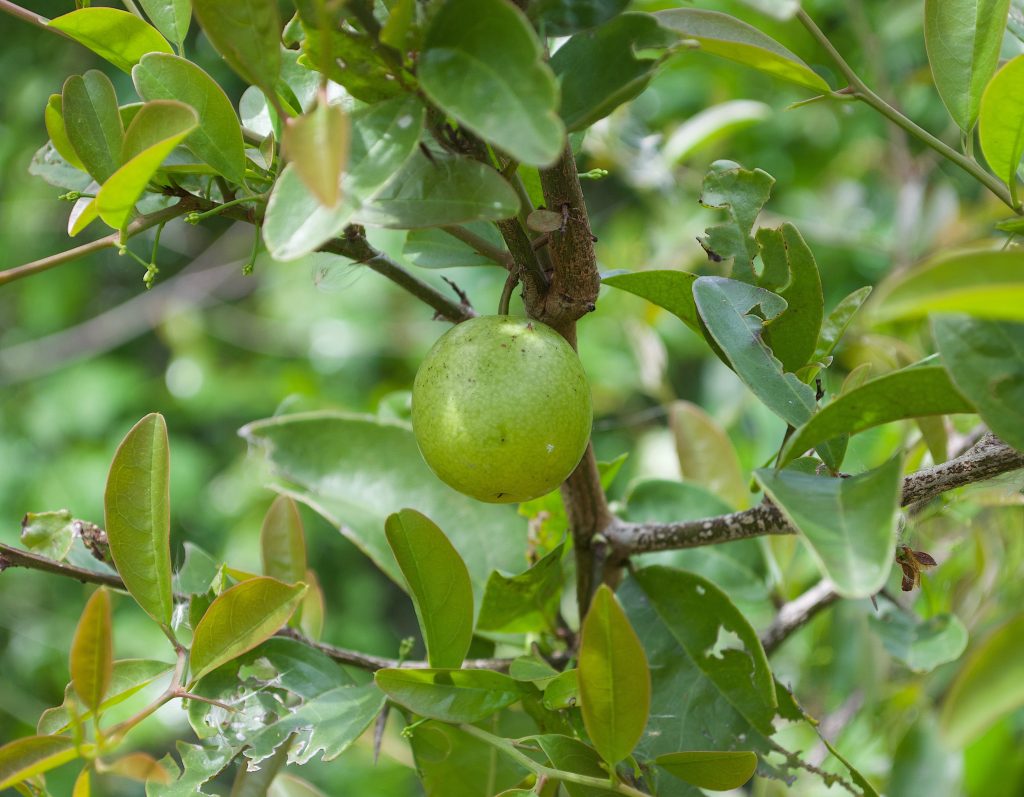
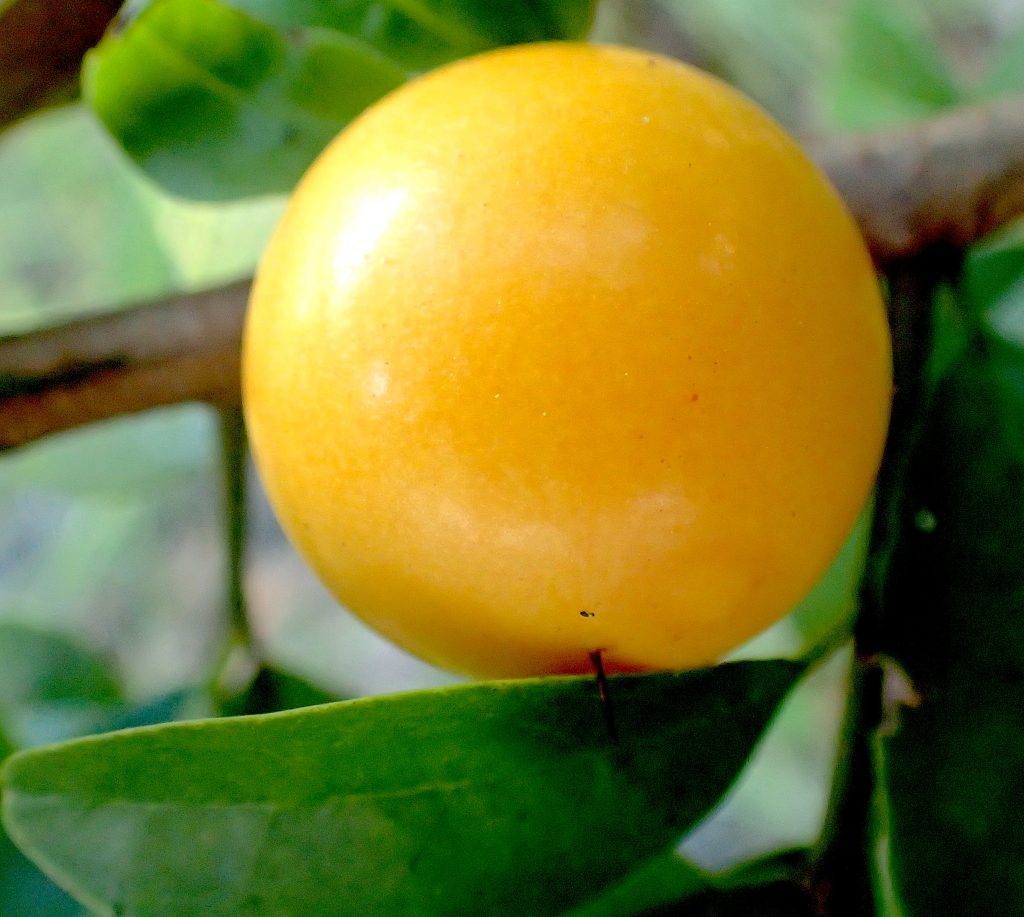
Tallow Plums are something of a botanical mystery. Are they semi-parasitic? Stand alone? Are many specimens in one area several separate plants or really just one specimen growing out of the ground in several places? And what of the name? Tallow Plum? Hog Plum? There are so many “hog” plums we might as well stay with Tallow Plum. When bright yellow ripe the plums are tangy, a bit tart and a bit sweet, chalky when unripe. The only other wild plant with yellow fruit that size — excluding escaped citrus — are Horse Nettles (Solanum carolinense.) They are herbaceous not woody and have huge spiny leaves. For many years I found Tallow Plums only along the coasts. Then after decades of looking I found one in Orange County, 20 miles west of Orlando. This past weekend we saw several blossoming and fruiting at a new foraging class location, Ft. Meade, Fl. which is in the middle of the state. Tallow Plums like sandy, dry places. At Ft. Meade they were up the hill from the Peace River and along the hiking trail . To read more about the Tallow Plum, go
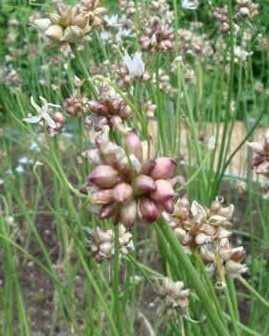
Doing well this time of year is Wild Garlic. You could also call it Wild Onion but its aroma is definitely garlic. Our Wild Garlic is odd in that it puts an onion-like bulb on the bottom of the plant (usually three or four inches in the ground) and puts cloves of garlic on the very top of the plant… and the part in between is edible as well. This garlic is seasonal and can be found for a couple of months if you take its entire cycle into consideration. April is usually its peak time. I have found it in many places from Orlando to Largo to Gainesville (where it is very common.) They like wet spots like ditches. One can also store the cloves in a paper bag in the refrigerator for months. You can read about Wild Garlic here.
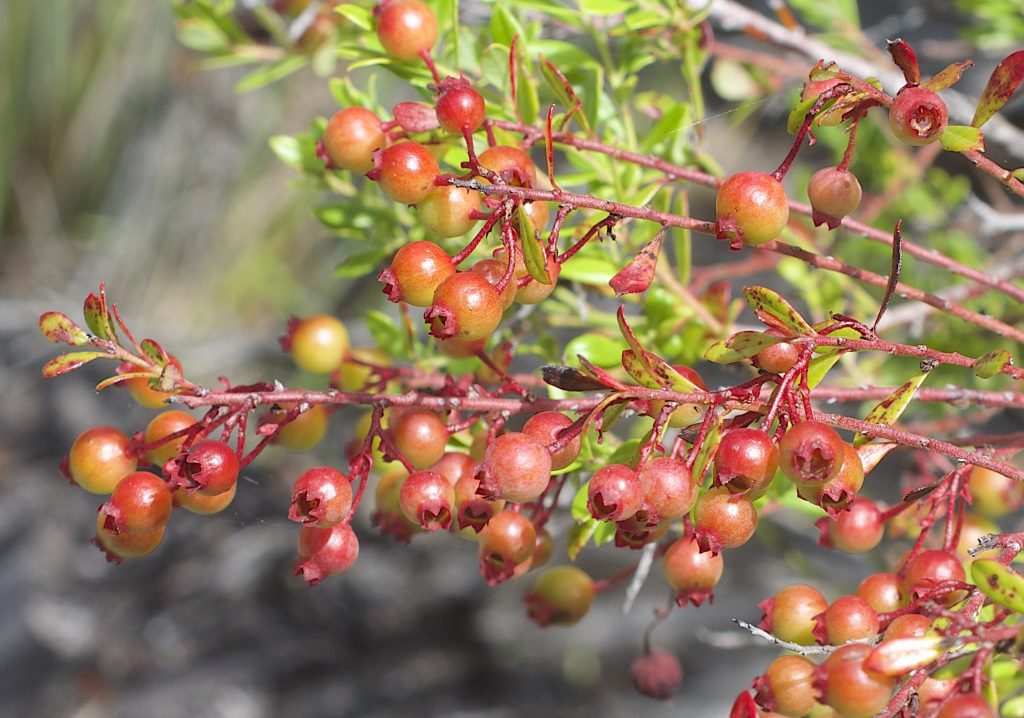
While the temperatures have been slightly on the cool side at night it’s been warm enough for plants in the day to know it’s spring and they are happy! April is a transition month. Many of winter edibles are ending their season while spring and summer plants are starting. There is overlap and that can vary depending which end of the state you are on. Blueberries and their kin won’t ripen for a while but they are setting among them Vaccinium arboreum. It’s commonly called Sparkleberry and Farkleberry and mistakenly Tree Huckleberry but it is not a huckleberry. It is the only blueberry locally that gets to tree size. Sparleberry has a flaking outer bark that reveals a reddish brown smooth inner bark. Also look for Deerberry, Vaccinium staminuem. That species is easy to identify because the blossoms have long stamens and the underside of the leaf is white. Incidentally, blueberries can have any number of seeds in them. Huckleberries, however, always have exactly 10 seeds. There can be bits of grit in a huckelberry but only 10 seeds. The leaves also have bright gold glands. You can read about blueberries here, Huckleberries here. Also in our Gainesville foraging class this coming Sunday we might also see a fruiting Aronia melanocarpa, the Black Chokeberry.
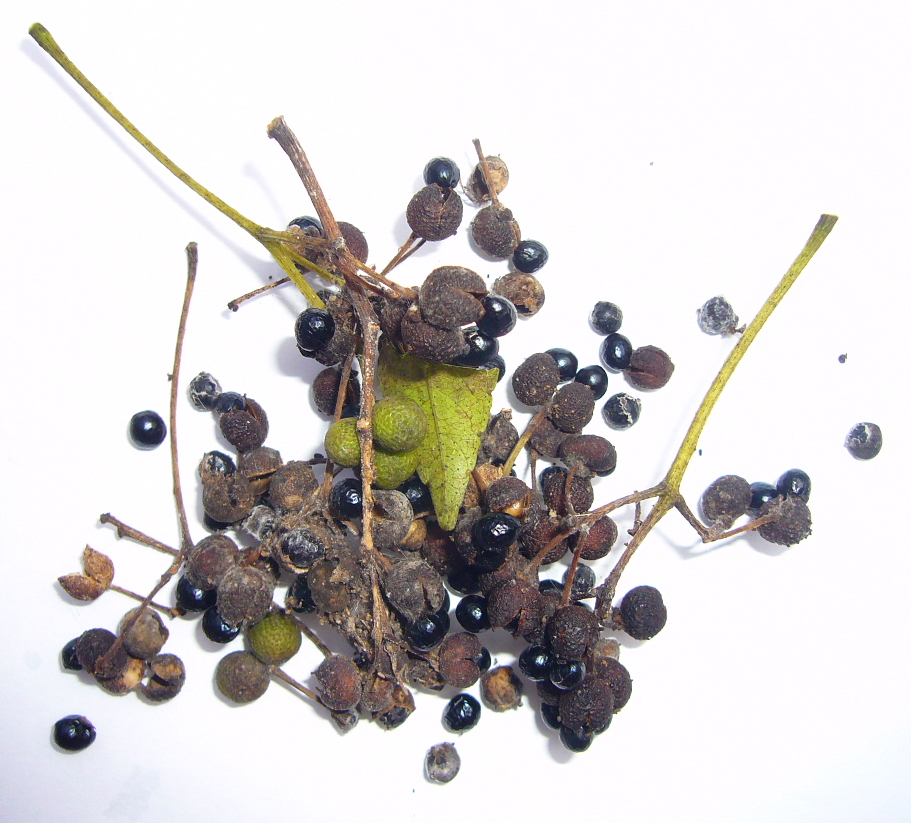
A couple of hundred miles can make a botanical difference. In Ft. Meade we saw a Toothache tree, Zanthoxylum clava-herculis, setting fruit. We’ll see the same species in Gainesville this weekend but probably just blossoming. Also called Hercule’s Club, the thorns, bark and leaves have been used at least for centuries to numb aching teeth. It will also make you drool, a small inconvenience to silence an aching tooth. You can read about it here. Many Americans have actually eaten part of a relative of the Toothache Tree, Szechuan Pepper, Zanthoxylum simulans (and Z. bungeanum.) That spice is made from the seeds hulls of the species. We can use the seed hulls of our tree for spice as well. The tree is covered with thorns so approach with care. Don’t mistake it for skinny, thorny shrub often seen in the same area as the Toothache Tree, Aralia spinosa, which is not related but is sometimes also called Hercules Club.
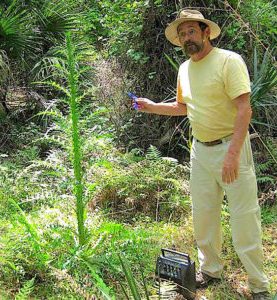
Foraging Classes: Heading north this weekend to Jacksonville Saturday and Gainesville Sunday, two pleasant locations and slightly different.
Saturday, April 6th, Florida State College, south campus, 11901 Beach Blvd., Jacksonville, 32246. 9 a.m. to noon. We will meet at building “D” next to the administration parking lot.
Sunday, April 7th, Boulware Springs Park, 3420 SE 15th St., Gainesville, FL 32641. 9 a.m. to noon. Meet at the picnic tables next to the pump house.
Saturday, April 13th, George LeStrange Preserve, 4911 Ralls Road, Fort Pierce, FL, 34981, 9 a.m. to noon. Meet at the parking lot.
Sunday, April 14th, Wickham Park: 2500 Parkway Drive, Melbourne, FL 32935-2335. 9 a.m. to noon.Meet at the “dog park” inside the park.
Saturday, April 20th, Blanchard Park, 10501 Jay Blanchard Trail, Orlando, FL 32817. 9 a.m. to noon. Meet next to the tennis courts by the YMCA building.
Sunday, April 21st, TBA
Saturday, April 27th, Red Bug Slough Beneva Road, Sarasota, FL, 34233. 9 a.m. to noon. Meet at the parking lot.
Sunday, May 5th: Ft. Meade Outdoor Recreation Area, 1639 Frostproof Highway, Fort Meade, FL 33841. (Frostproof Highway is also Route 98.) 9 a.m to noon. Meet at the brown bathrooms in the middle of the park which is due south from the highway.
Saturday, May 11th, Dreher Park, 1200 Southern Blvd., West Palm Beach, 33405. 9 a.m to noon. Meet just north of the science center in the north section of the park.
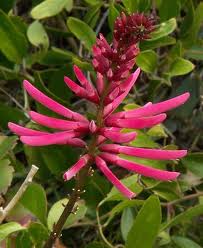
Also blossoming this time of year is the distinctive Eastern Coral Bean, sometimes called the Cherokee Bean. What is odd about this plant is the edible flowers produce toxic beans. So we do not eat the red and black beans. A few of the red blossoms are edible raw but they are usually boiled then mixed with other foods notably scrambled eggs. When you cook the blossoms they turn light green. The distinctive shape of the leaves makes the shrub easy to identify. Young leaves are edible cooked but are marginal fare. Like Pawpaws they prefer dry, sunny places. You can read more about the Eastern Coral Bean here.
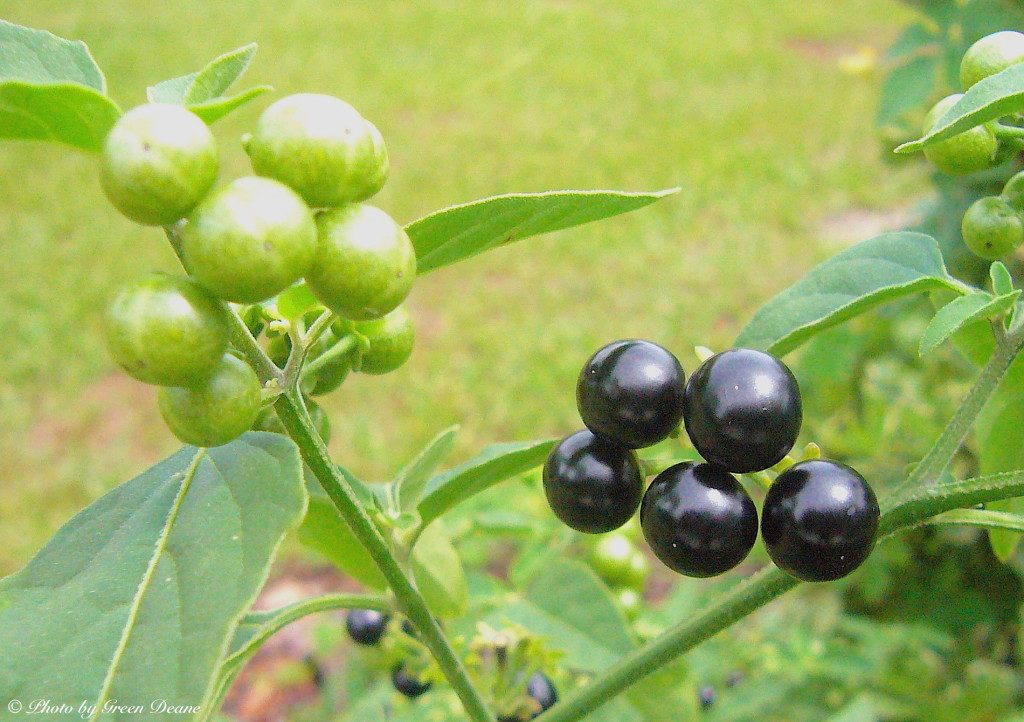
This week we also ate some fruit of the controversial American Black Nightshade, Solanum americanum. Several plants in the Nightshade family have one foot in edible and the other in toxic. The same is true with Honeysuckle and Pea family. I eat S. americanum berries as a trail side nibble often to the aghast of students or even other foragers. It’s a family with a lot of misunderstanding but also justified warnings about toxicity. If I have a problem with the S. americanum it is that the fruit is not consistent. Sometimes you find some very ripe but bitter fruit. Don’t eat those. Sometimes that are also larger than usual fruit and bitter. Perhaps there is some cross pollinating going on. Always taste a ripe berry first and wait a minute or two to see if any bitterness shows up. The green berries are definitely toxic. To read more about the American Nightshade go here.
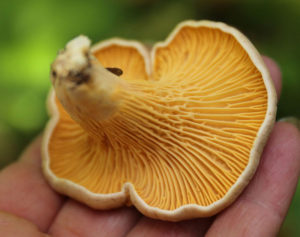
When will we be seeing mushrooms again? The answer is probably after spring rains in this month or early May. One can find various edible and medicinal mushrooms all year here but April or May to November or December is prime time depending upon weather. I harvested twelve pounds of chanterelles last year, half as many Milk Caps and some 80 pounds of Ringless Honey Mushroom (still eating the dried ones.) The topic of mushroom came up in the foraging class this week as we saw a Ganoderma curtisii starting its seasonal growth.
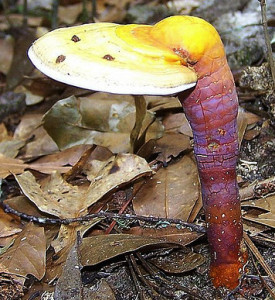
Also known as the medicinal mushroom Reishi, we have several species locally which is a bit of contention. The debate is how many species are there, what are they called, and are they as good as the ones that are sold for medicinal use? As for the latter my herbalist friends say yes, they are as good as the commercial kinds. As for how many and what they are called that probably won’t be settled for decades. I see about four regularly, it’s hard to tell. With certainty I see G. curtisii, G. sessile, G. lobatum, and G. zonatum. G. curtisii grows like a short golf club and is the closest relative to G. lingzhi, which is the well-known Chinese Reishi. G. sessile has no stem and grows horizontally (a smaller form is G. sessiliforme.) G. zonatum, more yellow than the rest, is found exclusively on palms and will kill the palm. If your palm has G. zontaum on it there is no hope for it. G. lobatum resembles G. applanatum and I always see it on oak stumps. There is also a Ganoderma that grows on citrus roots, G. tuberculosum but I have for certain seen it only once. To my knowledge none of the Reishis are toxic — but stick to identified species — and local herbalists report good results with them. These mushrooms stimulate the immune system by providing various molecular “keys’ that unlock and turn on immune cells in the gut. By the way I started and moderate these mushroom pages on Facebook: Southeast U.S. Mushroom Identification, Florida Mushroom Identification Forum, Edible Mushrooms: Florida, Edible Wild Mushrooms, and Orlando Mushroom Group which will start to have field trips as soon as the season turns.

Want to identify a plant? Looking for a foraging reference? Do you have a UFO, an Unidentified Flowering Object you want identified? On the Green Deane Forum we chat about foraging all year. And it’s not just about warm-weather plants or just North American flora. Many nations around the world share common weeds so there’s a lot to talk about. There’s also more than weeds. The reference section has information for foraging around the world. There are also articles on food preservation, and forgotten skills from making bows to fermenting food. One special section is “From the Frightening Mail Bag” where we learn from people who eat first then ask questions later. You can join the forum by clicking on “forum” in the menu.

All My Videos are available for free on You Tube. They do have ads on them so every time you watch a Green Deane video I get a quarter of one cent. Four views, one cent. Not exactly a large money-maker but it helps pays for this newsletter. If you want to see the videos without ads and some in slightly better quality you can order the DVD set. It is nine DVDs with 15 videos on each for a total of 135 videos. Many people want their own copy of the videos or they have a slow service and its easier to order then to watch them on-line. The DVDs make a good gift for that forager you know especially as spring is … springing. Individual DVDs can also be ordered or you can pick and choose. You can order them by clicking on the button on the top right hand side of this page (if your window is open wide enough.) Or you can go here.

Donations to upgrade EatTheWeeds.com have gone well. Thank you to all who have contributed to either via the Go Fund Me link, the PayPal donation link or by writing to Green Deane POB 941793 Maitland FL, 32794.
This is weekly issue 349.


Mr. Dean
I am going to try to make your Fort Mead class In May. I would like to know the price of your classes? I get your news letters and I like them very much.
Thank you
Mark Duncan, Lake Wales fl.
The class page on my website covers all that. The cost is $30 per adult per class.
I have found Tallow Plums (and many other wonderful edibles) in the Nature Preserve near my home in Riverview. We will definitely enjoy them when they are ripe. Thank you for educating us – can’t wait to take a class and meet you in person!